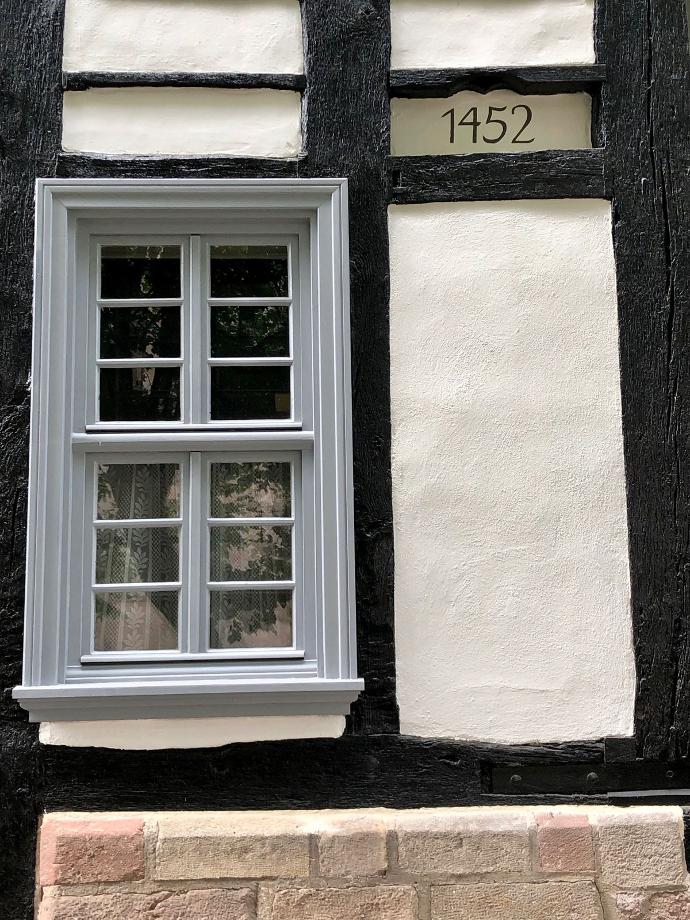Today as then
The selection of building materials that can be used correctly in the framework is relatively easy. It is precisely those from which people have been building their half-timbered houses for centuries: wood, clay, lime and linseed oil.
Even if carpenters vehemently claim it, wood is not the only building material in half-timbered construction, but an essential one, as it is of course responsible for the load-bearing structure as well as for the roof truss, ceiling beams and floors.
Even today, as since the beginning of half-timbered construction, the frames are filled with clay (although clay has been known as a building material for much longer; it was used as walls and floors thousands of years before the first half-timbered construction): They can be bricked up with the help of preformed earth bricks, fitted with timber struts, and filled with wickerwork made of willow rods, which is then covered with a straw clay mixture.
Ceiling surfaces are also prepared for the following plastering with timber struts or a clay fill, for which clay is of course also used.


Lime plaster and bricks
The use of lime as a plaster, which is applied to the massive clay layers, is recommended on the facade and an alternative to clay plaster in the interior. With such construction methods, however, the clay should definitely touch the framework directly, as it permanently protects the wood against moisture damage. A lime plaster is a bit more robust as a finishing plaster than a clay plaster.
Bricks also harmonize - under certain conditions - with a half-timbered house. Instead of filling the compartments with rammed earth, clay bricks or another earth building material, it is also possible to wall them with clinkers. Bricks are nothing more than shaped and burned clay and therefore a very pure material. However, there are significant differences among bricks, caused by their manufacture, which in turn have an impact on the building.
Bricks that are built into a framework should be fired relatively soft, i.e. not too hot, so that they still have the wonderful property of clay to regulate the humidity. Bricks that are burnt too hard, so-called clinker bricks, no longer absorb moisture and the joint has to manage the absorption of moisture. That is often not enough.
The material of the joints in a brick-lined framework should always be a little softer than the brick itself. Bricking with clay and grouting with lime in combination is ideal here. For the lime for grouting, you either use a ready-made material such as the Historic masonry mortar or a mixture of locally occurring sand with an NHL 2 or an NHL 3.5. The regional sand adapts the framework to a color typical of the surroundings.
Disharmonic building materials
Epilogue: Sooner or later, the use of plaster, cement, glass wool, mineral wool, polystyrene, laminate and other "modern" building materials always leads to damage in a half-timbered house. These building materials do not harmonize in any way with a healthy half-timbered building and should therefore not be found on the construction site in the first place - or be banned from it as soon as possible.
If, despite everything, the external circumstances mean that, for example, a concrete screed has to be poured, the bio-dynamic concrete liquid additive Pneumatit® is a way of bringing this rigid and lifeless building material back to life. Unlike clay plaster, concrete is dead matter.
Der Betonzusatzstoff Pneumatit® wird in den Frischbeton beigemischt.
Alle Ausgangsstoffe für Pneumatit® sind natürlicher Art: eine Reihe von Metallen, pflanzliche und mineralische Homöopathika und vieles mehr. Jede Substanz ist gewählt, weil sie bestimmte Kräfte in den Beton trägt, immer mit Hinblick auf Mensch und Welt.Total umfasst die Herstellung rund 100 Schritte über 2 Arbeitswochen. Das zur Anwendung bereite Endprodukt hat das homöopathische Format D7. Auch deshalb geht von Pneumatit® keinerlei physikalische oder chemische Beeinflussung des Baumaterials aus.

Linseed oil products for protection
Paints protect the framework from UV light and weathering. Because of the desired openness to diffusion, the use of linseed oil products is recommended. Raw linseed oil for priming can easily be painted over with linseed oil paints or linseed oil glazes in the next step. Linseed oil glazes provide the wood with enough pigment to protect it against UV radiation. Higher proportions of pigment, as found in linseed oil paints, also offer higher UV protection. This protection of timber framing is necessary, since environmental influences such as UV light and rain would otherwise decompose them.
